
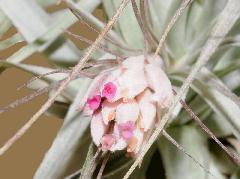
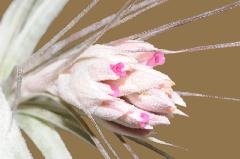
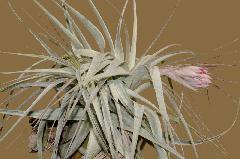


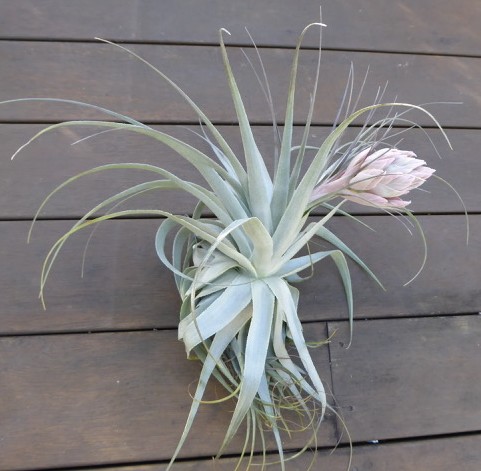
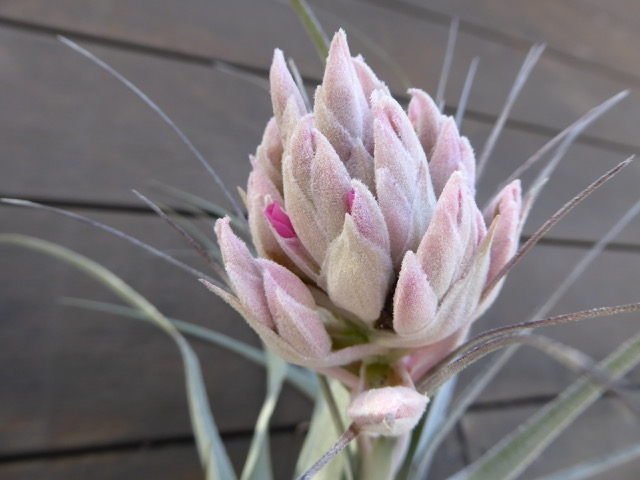
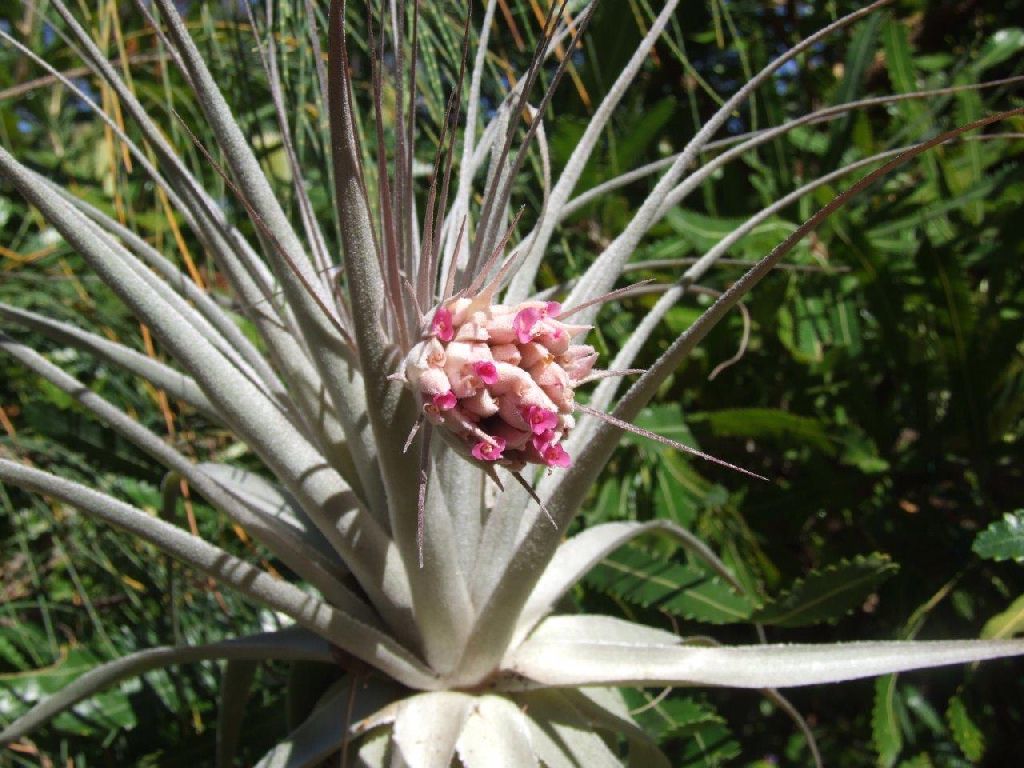
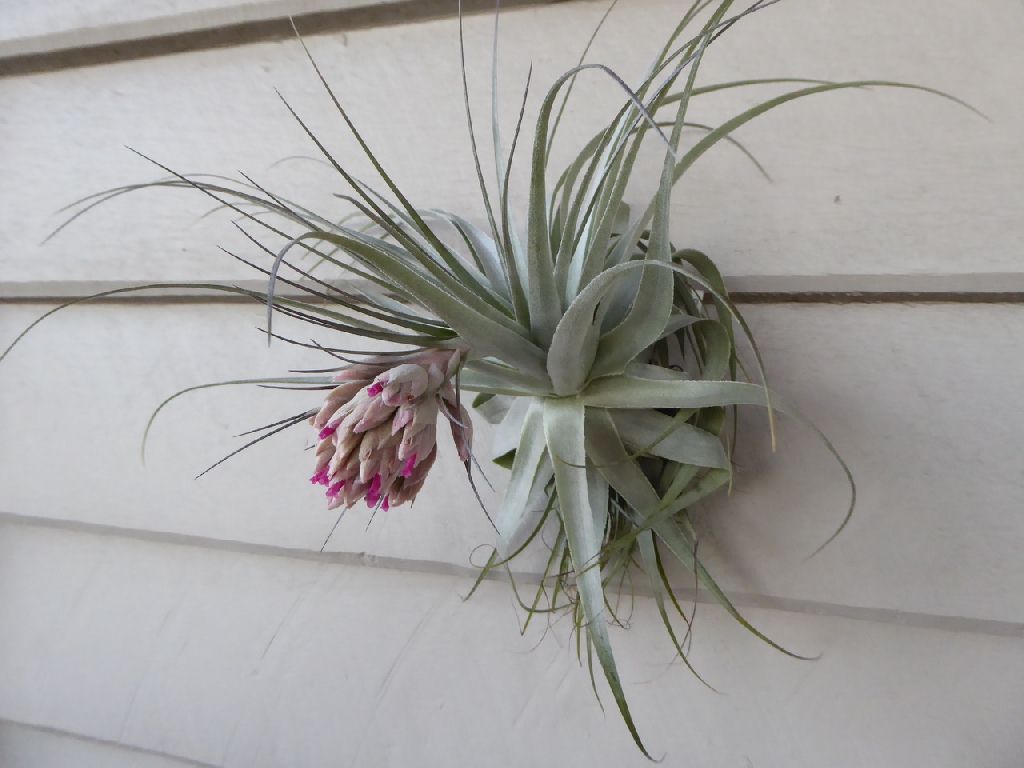



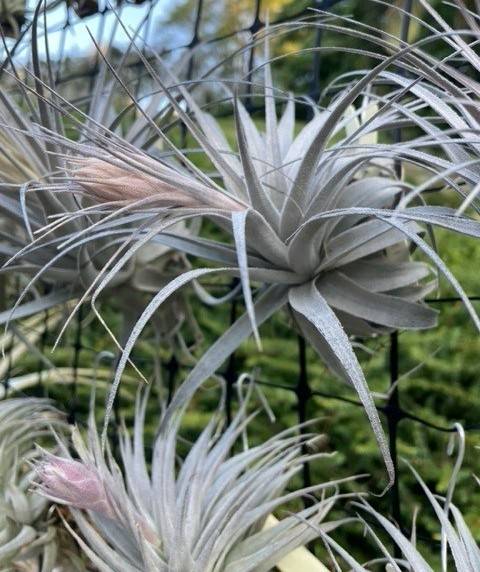
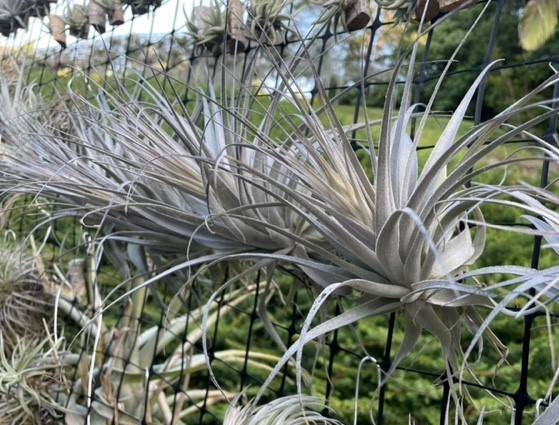
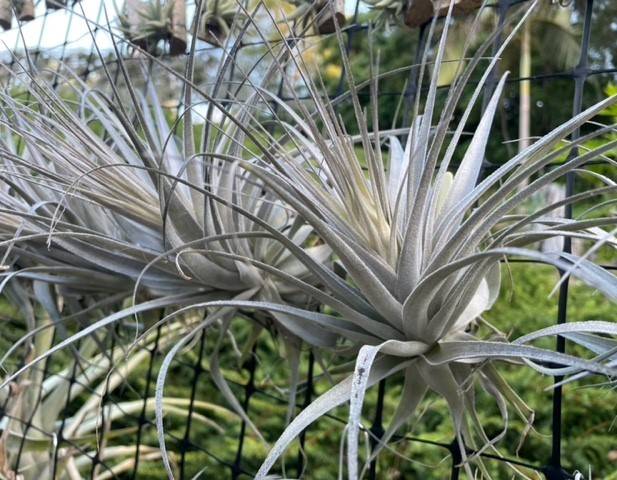
Tillandsia gardneri Lindl var rupicola Pereira, Bradea 3: 214-5. 1981
Tillandsia gardneri Lindl. var. cabofrioensis Weber et Ehlers JBS. 32:110-1. 1982
Differt a forma typica et a varietatibus adhunc cognitis, habitu longe caulescenti, foliis persecundis, corola alba et limbis bractearum scapalium aliquantum minoribus.
Differs from Type in -
Plant long caulescent.
Leaves very secund
Scape bracts blade somewhat smaller
Corolla white
TYPUS: Estado do Rio de Janeiro, Municipio de Cabo Frio, Ilha do Farol, sobre rocha, corola alba. Leg. Luiz Knud Correia de Araujo no.24, em 15 de Agosto de 1980. HOLOTYPUS - HB No. 71.211.
Tillandsia gardneri Lindl. var. cabofrioensis Weber & Ehlers Note that this variety was made synonymous with var rupicola in De Rebus I 1994 (from J Brom Soc 33: 79. 1983)
PLANT: up to 30 cm long, caulescent;
LEAVES: many, along the stem dense polystichous arranged, the older strongly recurved and mostly hidden by the stem, the younger erect to spreading, shorter as the scape, very dense white pruinose lepidote;
SHEATHS: indistinct, at base subglabrous, whitish, to 20 mm wide;
BLADES: narrow triangular, 9-10 cm long, few canaliculate, more soft than stiff, pale green, dense pruinose and the margins fimbriate lepidote, apex subobtuse attenuate;
SCAPE: 12 cm long, terete, stout, about 6 mm in diameter, pale green, dense white lanate lepidote;
SCAPE BRACTS: lance-ovate, dense imbricate, equal to or exceeding the internodes, the lower subfoliaceous, the upper with long subulate blades but all shorter at the base of the inflorescence, dense pruinose lepidote;
INFLORESCENCE: subglobose, dense, composed from 6- 7 spikes, 45 mm long, 35 mm in diameter;
PRIMARY BRACTS: like the upper scape bracts, ovate, acute, shorter than the lateral spikes, 24 mm long, 12 mm wide, roseate, dense tomentose white lepidote;
SPIKES: subdense distichous 2-4 flowered, rhachis stout, dense tomentose;
FLOWERS: erect, sessile, 26 mm long;
FLOWER BRACTS: erect, lanceolate, acute, 18-20 mm long, to 10 mm wide, coriaceous, carinate, at base with thickened middlenerve, roseate, dense tomentose lepidote, exceeding the sepals;
SEPALS: lance-elliptic, broadly acute, 11-12 mm long, to 4 mm wide, posteriorly only 1 mm connate, carinate, at base with thickened middlenerve, whitish, at apex pale roseate, even, with hyaline margins, glabrous, only at the extreme apex and at base of the middlenerve few tomentose;
PETALS: linear, 22 mm long, with 10 mm long and 4 mm wide ovate blades, base tubular , white, blades subspreading and pale violaceo-roseate;
STAMENS: included, 13 mm long, white, flattened, in the upper 1/4 part only single transversal plicate;
ANTHERS: linear, thin, scarcely 2 mm long, yellow, basifixed;
only PISTIL: visible in the claw, terete, white, 15 mm long;
STIGMATA: very small, white,
OVARY: subglobose, about 2 mm high, pale green, glabrous.
leg. Renate Ehlers, July 1981, BRAZIL, Ilha Cabo Frio, 5 msm, directly above the surf-zone saxicolous on cliffs;
HOLOTYPE WEB 325. This very interesting variety is already known under the collector's name Tillandsia gardneri 'lilacina'.
Tillandsia gardneri Lindl. var. virescens Pereira, Bradea 2:309. 1979
Differt a forma typica inf1orescentia totaliter viridi.
Inflorescence, including the bracts, and also the scape scape-bracts is green in this variety.
Habitat: Estado do Rio de Janeiro, Guaratiba, Munic. Rio de Janeiro. Legit. cl. Ivo de Azevedo Penna s.n. 01.SEPT.1978. HOLOTYPUS HB-67524.
Note. R Ehlers spent one whole day at location looking for this variety in vain!
TILLANDSIA CAMBUQUIRENSIS Alv. Silva, Floralia Montium 2: 27. 1931
Epiphyta. Caulis perbrevis. FOLIA rosulata, quaquaversa, utriculum haud efformantia, e basi ad apicem sensim angustata, acuta, pallide viridia, recurva, supra canaliculato-concava, chartacea, utrinque lepidibus albis obsita, sericantia, circiter 13cm longa, medio 10-13 mm lata. INFLORESCENTIA multiflora, 5-7 spicis quaquaversis composita paniculata, e foliis centralibus enascens, scapo recto inferne glabro superne sparse lepidoto rubro, 10 cm longo elata, foliolis lineari-lanceolatis acutis reflexis utrinque albolepidotis apicem versus scapi brevioribus inferne am-plexicaulibus, paucis, e basi roseis ad apicem angustioribus et virescentibus, summis inflorescentia haud superantibus. SPICA singula 2-3- flora, 2, 5 cm longa, complanata. BRACTEAE FLORALES late ovatae, roseae, utrinque lepidotae, sepalis paullo breviores, acutae, concavae. FLORES erecti, 15-18 mm longi. SEPALA 3, rosea,ovato-lanceolata, acuta summo dorso uno alterove lepide intructa antico cum reliqua ad 1, posticis inter sese ad 3 mm connata, per anthesin bractea superantia. PETALA 3, usque 1, 5 cm longa, rubra, ex ungue linearia in laminam ovalem emarginatam reflexam producta, glabra sepalis circiter 5 mm longiora. STAMINA 6, inclusa, filamentis usque ad medium linearibus e medio ad apicem lanceolatis, acutis,quam petala 5 mm brevioribus, membranaceis, media parte geniculatis; antherae lineares, fuscae,in 1/4 altitudine dorsifixae, 2 mm longa:.OVARIUM elip-soideum, glabrum. STYLUS apice ovarii enascens, in altitudine filamenta atherarum aequans, albidum . STIGMATA indivisa, albida. CAPSULA 3 cm longa, valvis non tortis 3-nervis, usque ad basin dehiscentibus, intus albidis et rugulosis, extus castaneo-fuscis ac nitentibus. SEMINA 2, 5 cm longa, fusca, numerosa, in media parte pilorum niveorum sericantium coma aucta
In capociras prope Cambuquira, Minas Geraes: Alvaro da Silveira. Apr. 192; n.° 8126 in herbarto Silveira. Tabula XI
Species a T. Regnelli Mez lepidibus albis (non ferrugineis), foliolis quam sepala brevioribus, adjunctione sepali antici cum reliquis (1 mm et non 2), et aliis characteribus, differt; a T. venusta Alv. Silv. lepidibus partium floralium haud dissimilibus illorum alliorum partium praecipue differt.
English translation
Plant epiphytic, stem very short
Leaves rosulate, polystichous, an utriculum not at all without form, gradually tapering from base to tip, acute, pale green, recurved, upper side channelled concave, chartaceous, both sides covered with white lepidote, silky, about 13cm long, in the middle 10-13mm wide.
Inflorescence many flowered, 5-7 polystichos spikes forming a panicle, emerging from the centre of the leaves.
Scape erect, lower part glabrous, upper part sparse red lepidote, 10cm long,
Scape bracts linear-lanceolate acute, reflexed, both sides white lepidote, shorter towards the top of the scape, lower ones enclosing the scape, few, pink towards the base and narrowing and greenish towards the tip, not at all exceeding the top of the inflorescence
Spikes each with 2-3 flowers, 2.5cm long, complanate.
Floral bracts broad ovate, pink, both sides lepidote, sepals a little shorter, acute, concave.
Flowers erect, 15-18mm long.
Sepals 3, pink, ovate-lanceolate, acute at the top on the back, the anterior one joined to the others for 1mm, posterior pair joined for 3mm, during flowering exceeding the bract.
Petals 3, to 1.5cm long, red, claw linear, blade oval, emarginate, reflexed, glabrous about 5mm longer than the sepals
Stamens 6, included, filaments up to the middle linear, from middle to the tip lanceolate, acute, 5mm shorter than the petals, membranaceous, middle part geniculate;
Anthers linear, brown, dorsifixed ¼ high, 2mm long;
Ovary ellipsoid, glabrous;
Style tip not starting at the ovary, equalling the height of the anther filament, white.
Stigmata not divided, white
Capsule 3cm long, vales not twisted 3 nerved, dehiscent fronm near the base, inside white and rugulose, outside dark brown, shiny
In brush-wood near Cambuquira, Minas Gerais: Alvaro da Silveira. Apl. 192(?5): no. 8126 in herbario Silveira
Differs from T. Regnelli by white lepidote (not brown), bracts shorter than the sepals, anterior sepal joined to the others (1mm not 2mm), and other characters.
Differs from T. venusta Alv. Silv. the lepidote parts not at all dissimilar but all other parts mainly different
TILLANDSIA VENUSTA Alv, Silv. Floralia Montium 2: 29. 1931
Epiphyta. FOLIA dense rosulata, utriculum haud efformantia, quaquaversa, dense lepidibus maximis haud stellatis obtecta, plus minusve sericantia, inferne lato-linearia apicem versus sensim angustata emum longe subfiliformia, quasi plana, glauca arcuato-reflexa vel refracta, 11-18 cm longa, prope basin 12 mm lata. INFLORESCENTIA multiflora, e spicis 6 - 10 ad 30 mm longis subaequalibus manifeste complanatis composita paniculata, e foliis centralibus prodiens eaque fere aequans, scapo recto angulato albo-lepidoto et 12 cm longo elata, foliolis paucis e basi ovata rosea ac longe angusteque acuminatis , dense albo-lepidotis, summis inflorescentia paullo superantibus. SPICA singula circiter 3 cm longa, 3-flora, complanata. BRACTEAE florales late ovatae, inferiores longiuscule acutae, superiores acutae, sepala longiores, pulchre roseae, dorso dense lepidibus stellatis obsitae, infimae exceptae distiche dispositae, concavae. FLORES erecti, 2 cm longi, sessiles, per anthesin bracteam 3-5 mm superantes. SEPALA 3,ovato-lanceolata, apice pallide rosea ceterum pallido viridia, acuta, 1 cm longa, margine paullo lepidota, tubum quasi cylindricum formantia, petalis adpressa, anticum cum reliquis ad 2 mm,postica inter sese ad 3 mm connata. PETALA 3, e medio ad apicem rubra, inferiore parte albida, ex ungue late linear a in laminam late ovalem dilatata, apice reflexa, 2 cm. longa, fere usque apicem tubum exacte cylindricum efformantia, glabra. STAMINA 6, inclusa, quam petala 2 mm bre-viora, filamentis 1 cm longis, aequalibus, glabris, antherae luteae, 2, 5 cm longae, in 1/5 altitudinis dorsifixae. OVARIUM ellipsodeum, glabrum. STYLUS apice ovarii enascens, quam petala brevior. STIGMATA antheras multo breviora, indivisa, pallide rosea.
In capoeiras prope Milho Verde, Serra Geral, Minas Geraes: Alvaro da Silveira, jun. 1925; n.° 793 in herbario Silveira. Tabula XII
Species a T. Regnelli Mez scapo angulato spicis manifeste complanatis, inflorescentia albolepidota, foliolis paucis albo-lepidotis summis inflorescentiam paullo superantibus et stigmato antheris breviore praecipue differt; a T. fluminensi Mez etiam proxima, lepidibus albis (non ferrugineis), stigmato antheris breviore et sepalorum conjunctione facile distinguenda.
English translation
Plant epiphytic
Leaves densely rosulate, an utriculum not at all without form, polystichous, covered with large lepidote not at all starlike, more or less silky, the lower part broad linear gradually tapering towards the tip then long almost filiform, nearly complanate, glaucous bow-reflexed or refracted,11-18cm long, near the base 12mm wide,
Inflorescence many flowered, with 6-10 spikes to 3cm long, subequal, clearly complanate forming a panicle, produced from the centre of the leaves and almost equalling them
Scape erect, angled, white lepidote and 12cm long
Scape bracts few, ovate at base, pink, long narrow acuminate, dense white lepidote, the top ones a little exceeding the inflorescence
Spikes about 3cm long, 3 flowered, complanate
Floral bracts broad ovate, lower ones longish acute, upper ones acute, longer than the sepals, beautiful pink, the back with dense stellate lepidote, except the lower part distichously disposed, concave
Flowers erect, 2cm long, sessile, during anthesis exceeding the bracts by 3-5mm.
Sepals, 3, ovate lanceolatetip pale pink otherwise pale green, acute, 1cm long, edges a little lepidote, forming an almost cylindrical tube, adpressed to the petals, anterior connate to 2mm, posterior pair connate to 3mm
Petals 3, from middle to top red, lower part white, claw broad linear dilated to wide oval blade, tip reflexed, 2cm long, forming an almost cylindrical tube at the top, glabrous.
Stamens 6, included2mm shorter than the petals, filaments 1cm long, equal, glabrous; anthers yellow, 2.5cm (?mm) long, dorsifixed 1/5 high
Ovary ellipsoid, glabrous, Style not originating from the top of the ovary, shorter than the petals, Stigmata much shorter than the anthers, undivided, pale pink.
In brush-wood near Milho Verde, Serra Geral, Minas Gerais, Alvaro da Silveira, June 1925; No. 793 in Herbarium Silveira
Differs from T. Regnelli Mez by the angled scape and clearly complanate spikes, inflorescence with white lepidote, scape bracts few, white lepidote, the upper ones a little exceeding the inflorescence, stigmata mainly shorter than the the anthers.
Differs from T. fluminensis similarly, white lepidote (not brown), stimata shorter than the anthers, and the joining of the sepals.
Two Locally Endemic Brazilian Tillandsias by Elton M.C. Leme in J. Brom. Soc. 37: 217-9. 1987
In the coast, contrasting with the blue-green ocean, there are solid walls of stony hills up to 400 meters high. Here and there, they break the monotony of the scenery and block the way to the sandy plains. The vegetation is typical of the sand dunes. Dense and continuous, it varies between the shrubby and the arboreous. At points it is so dense that it nearly eliminates bromeliads. Billbergia iridifolia (Nees & Martius) Lindley, an epiphyte growing just above the ground is the only exception. But where the sunlight pierces the lower stratum of the vegetation, large formations of Cryptanthus spp., Nidularium atalaiaensis Pereira & Leme, as well as other species, can be seen growing on the ground or on rocks. Sometimes, because they are so big, specimens of Bromelia antiacantha Bertoloni and Streptocalyx floribundus (Martius ex Schultes filius) Mez can be seen growing as terrestrials and surpassing the height of the woody vegetation.
On the granitic walls where most species of plant life cannot grow, cactus columns appear in the middle of thickets of Neoregelia cruenta (R. Graham) L.B. Smith (Fig. 8), Quesnelia quesneliana (Brongniart) L.B. Smith, Billbergia tweedieana Baker, and conspicuous formations of Tillandsia neglecta E. Pereira. The sun and wind are merciless.
There are rocky islands near the shore cut off from the mainland by the wave action of centuries. These islands are inhabited by the same animal and plant species found on the mainland. We have one particular island in mind. It is the only place, to our knowledge, where Tillandsia gardneri Lindley var. rupicola E. Pereira grows. It is Cabo Island, also known as Farol Island.
All of this scenery was created by the forces of nature in the vicinity of Arraial de Cabo, State of Rio de Janeiro, about 160 km east of the city of Rio de Janeiro by highway.
The village of Arraial de Cabo, formerly a district of the County of Cabo Frio, was recently given a higher status, thus becoming politically and administratively autonomous. In spite of the destructive actions of men begun in this region in the 16th century, the natural areas of this new county are still reasonably well kept. The largest one is the Massambaba, a narrow sand barrier between the sea and the Araruama Lagoon. This sandy plain with its rolling lands has sparse vegetation, low growing and adapted to these dry and hot conditions. The plants very often form islands surrounded by winding rows of sand (Fig. 9). The edges of the islands are the habitat of terrestrial sun-lovers such as Aechmea pineliana (Brongniart ex Planchon) Baker, Neoregelia cruenta, N. eltoniana W. Weber, Portea petropolitana (Wawra) Mez and Vriesea neoglutinosa Mez.
Among the epiphytes are Aechmea lingulata (Linnaeus) Baker, Billbergia euphemiae E. Morren, B. zebrina (Herbert) Lindley, and Tillandsia gardneri Lindley var. gardneri.
Where the soil is deeper the vegetation grows eight to 12 meters high encouraging the growth of other bromeliad species as for example Aechmea sphaerocephala Baker, Billbergia pyramidalis (Sims) Lindley var. lutea Leme & Weber, Vriesea procera (Martius ex Schultes f.) var. rubra L. B. Smith.
As a result of the comparative preservation of these areas and also as a result of a survey made in this region, I positively established the existence of 36 bromeliad species, of which 30% are endemic. Because of their peculiarities, two of the species attracted our attention. They are Tillandsia neglecta and T. gardneri var. rupicola.
Tillandsia neglecta (Fig. 10) described in 1971 on the basis of material collected by Dimitri Sucre, has caused specialists to disagree as to its validity. In the highly respected opinion of Dr. L.B. Smith this species might be considered a synonym of T. tenuifolia var. surinamensis (Mez) L.B. Smith. On the other hand, Wilhelm Weber's views are that T. neglecta is more related to T. stricta Solander ex Ker-Gawler, but distinct from it. In fact, Edmundo Pereira in describing the species considered it taxonomically more closely related to T. stricta, pointing out as differences between them the distinct caulescent habit of T. neglecta, the degree of concretion of its posterior sepals, and the shape of the leaves. We consider the species valid, that in its habitat it bears great resemblance to T. araujei Mez, although sturdier. As to the floral elements it is really nearer to T. stricta.
Growing on the rocky cliffs of the mainland as well as on islands, T. neglecta develops in thick populations. The coloring of its leaves, which varies from yellowish green to bronze, is striking. Atalaia Hill and Cabo Island, separated by a few hundred meters, nowadays contain larger concentrations of the species. The island may be considered a nature preserve. Besides its isolation, the island has had the benefit of protection by the Brazilian Navy which does not allow unauthorized visitors. It has all kinds of sand bank vegetation from the shrubby to the arboreous. Its height is up to 406 meters and the forest that grows above the 200 meter line resembles the flanks of the Atlantic forest because of the marked humidity. It is interesting to note that of 20 different species of bromeliad growing on the island at least two of them, T. geminiflora Brongniart and Vriesea gigantea Gaudichaud, are typical of the Atlantic forest and have never been found growing in similar sandy locations on the mainland. The other species are mostly represented by members of the subfamily Bromelioideae and also grow on the mainland, in sand dunes nearby, without any noteworthy morphological variation between island and mainland populations. The only exception is T. gardneri var. rupicola which appears only on the rocky walls on the bare side of Cabo Island.
While the typical T. gardneri is chiefly of epiphytical habit with individuals more or less sparsely distributed within its ample area of occurrence, var. rupicula, as far as is known, entirely covers the rocky slopes (Fig. 11) with extremely dense populations, resembling the style of T. neglecta. It also grows side by side with T. neglecta.
Edmundo Pereira described this variety in 1981 on the basis of a specimen collected by Luiz Correia de Araujo. He found among the characteristics that distinguish the var. rupicola from the typical variety the unusual habit, the shape of the plant with strongly secund leaves, the branches of the inflorescence more spread out, and the coloring of the petals. At first, only the white color of the petals was known-seemingly the predominant pattern of the variety. Later, it was found that the petals may be of a bluish color, which may be a result of a process of hybridization with T. neglecta.
There is an interesting question about the origin of the species; the way in which it could have developed until its present condition. At first, we believed that because of its comparative isolation, the population of the island had adjusted to local conditions becoming different from the typical T. gardneri on the mainland. But if we consider that of all the bromeliological flora of the island only this variety is an exclusive element of the place, and that there are also species originating from the somewhat distant Atlantic forest, it is also a reasonable admission that the var. rupicola could have had a population much more widely distributed in the past. It might have grown on the rocky cliffs emerging from Atlantic heights like the Orgao Mountains. Because of some unknown factors, they have disappeared from these surroundings leading us to the conclusion that the population of Cabo Island could be relics, witnesses of old periods of vegetation. It is obvious that more studies and observations will be necessary in order to understand the mysteries enveloping T. gardneri var. rupicola.
Either of these varieties or the T. neglecta can be cultivated with comparative ease on pieces of tree branches. They will bloom every year without any special care.
In January 1987, in one of the last acts of the State government, it was directed that the sand banks of Arraial de Cabo would be considered an area of permanent preservation or of limited use. There is, however, concern that the new government may not continue to support the idea of preservation. In spite of these worries, there is a good probability that Cabo Island, because of its comparative isolation, will continue to be preserved over the years, a guarantee of survival of the flora and fauna of the region for present and future studies, or merely for the delight of those who love nature.
Detail from Mez 1935 Key
b) Spicae pluriflorae.
1. Spicae brevissimae, in capitulum compactum contractae => 318. T. Gardneri.
2. Spicae elongatiores, manifeste distinctae.
§ Sepala 2 postica ad 2 mm connata; bracteae florigerae carinatae => 319. T. fluminensis.
§§ Sepala postica ad 3 mm connata; bracteae florigerae haud carinatae => 320. T. Regnellii.
318. T. Gardneri Lindl. in Bot. Reg. XXVIII. (1842) sub t. 63.
Anoplophytum incanum Morr. in Belg. Hortic. XXXI. (1581) 209, t. 11.
A. Rollissonii Morr. in The Garden (1878) 39, nomen, e. p.
Tillandsia argentea Hort. (non alior.) ex Morr., I. c.
Ad 0,12 m alta, acaulis. Folia exteriora reflexa media interioraque erecta, usque ad 0,16 m longa, basi ad 10 mm lata, inde in apicem tenuissimum filiformem nullo modo pungentem persensim angustata, omnino plana, lepidibus maximis pruinosis obtecta argentea. Scapus usque ad 0,1 m longus, dense lepidotus, foliis iis rosulae similibus sed angustioribus erectis dense indutus. Inflorescentia submultiflora, percompacte 2-pinnatim panniculata, e spicis brevissimis 5-12 dense composita, foliis brevior, ad 40 mm longa et 50 mm diam. metiens; spicis dense flabellatis, 4-6-floris, ovatis, acutis, suberectis vel erectis; bracteis primariis infimis foliolis scapalibus, summis bracteis secundariis isomorphis; bracteis florigeris e late ovato longe acutis, dorso dense lepidotis, coriaceis, praesertim apicem versus conspicue carinatis, ad 14 mm longis, sepala superantibus. Flores erecti, ad 15 mm longi; sepalis antico libero, posticis ad 1,5 mm connatis, 10 mm longis, subovalibus, acutis, crasse coriaceis, dorso lepidotis, laevibus. Petala rosea, 14 mm longa, laminis anguste ovalibus, rotundatis, oblique emarginatis, undulatis. Stamina inclusa quam stylus breviora.
Trinidad (Broadway n.2631, Britton n. 1181, Buthu n. 11978, Fendler n. 822). - Brasilien: Staat Bahia (Blanchet n.935); Rio de Janeiro (Gardner n. 134, Glaziou n. 11676 e. p.,Riedel n.540); Sta. Catharina (F. Muller, Schenck); Minas Geraes (Schwacke). - Ich babe die Art lebend vom Munchener Garten erhalten.
319. T. fluminensis Mez in Mart. Fl. Brasil. III. 3. (1894) 591.
Acaulis, ad 0,12 m alta. Folia exteriora mediaque reflexa interiora suberecta, chartacea, ad 0,1 m longa, 12 mm lata, linearia, apicem crasse subfiliformem versus sensim acuta, lepidibus maximis obtecta plus minus sericantia. Scapus ad 60 mm longus, dense lepidotus, foliis permultis e late ovali perlonge angusteque acuminatis, dense lepidibus ferrugineis obtectis, summis inflorescentiam dimidio aequantibus, membranaceis indutus. Inflorescentia multiflora, e spicis 6-10 ad 40 mm longis, subaequalibus, laxiusculis subflabellatis, 6-12-floris composita 2-pinnatim panniculata, ad 60 mm longa et 50 mm diam. metiens; axibus dense lepidoto-tomentosis; spicis lanceolatis, acutis, erectis; bracteis primariis foliolis scapalibus isomorphis sed breviter acuminatis vel acutis; bracteis florigeris late ovatis, breviter acutis paulloque mucronatis, dorso dense ferrugineo-lepidotis, coriaceis, ad 15 mm lougis, sepala superantibus. Flores erecti, ad 16 mm longi; sepalis antico cum reliquis ad 1 mm, posticis inter sese ad 2 mm connatis, subovalibus, acutis et mucrone miti praeditis, coriaceis, carinatim complicatis, paullo lepidotis, ad 10 mm longis. Petala rosea, fere 15 mm longa, laminis late ovalibus, rotundatis, oblique emarginatis, suberectis. Stamina haud exserta, stylum subaequantia.
Brasilien: Rio de Janeiro (Luschnath).
320. T. Regnellii Mez in Mart. Fl. Brasil. III. 3. (1594) 592, t. 110.
Acaulis, ad 0,17 m alta. Folia permulta plane rosulata, exteriora patentia media interioraque suberecta vel erecta, ad 0,17 m longa et 14 mm lata, linearia, apicem longe subfiliformem versus persensim acuta, plana, utrinque lepidibus maximis obtecta sericanter pruinosa. Scapus foliis bene brevior, dense foliolis permultis erectis, iis rosulae aequalibus sed angustioribus indutus et celatus. Inflorescentia multiflora, compacte 2-pinnatim panniculata, e spicis 5-10 ad 30 mm longis crassis fere teretibus composita, folia exacte aequans; axibus dense ferrugineo-lepidotis; bracteis primariis foliolis scapalibus isomorphis sed brevius acuminatis vel superioribus acutis; bracteis florigeris e late ovato longiuscule acutis et paullo mite mucronulatis, dense ferrugineo-lepidotis, coriaceis, ad 15 mm longis, sepala superantibus. Flores erecti, ad 18 mm longi; sepalis antico cum reliquis ad 2 mm, posticis inter sese ad 3 mm connatis, latissime ovatis, acutis miteque paullo mucronulatis, coriaceis, margine minute fimbriatis cet. glabris, fere 14 mm longis. Petala 17,5 mm longa, rosea, laminis :ovalibus, rotundatis, cucullatis indeque acutarum speciem praebentibus, suberectis. Stamina vix emergentia, quam stylus minute breviora.
Brasilien : Minas Geraes, bei Caldas (Regnell III. n. 1798).
Key to Brazilian Tillandsias, with red or pink petals from Die Bromelie, Sonderheft 3 1996
1. Stamens - exceeding the flower tube => paraensis
- included in the flower tube => 2
2. Leaf blade - filiform and grasslike => globosa
- triangular => 3
3. Plant - 4 - 8 cm in diameter => 8
- 10 - 25 cm in diameter, forming a more or less spreading rosette, stemless => 4
4. Floral bracts - lepidote => 5
- glabrous or nearly so: Plant 6 - 15 cm diameter, inflorescence elliptic or globose, spikes elliptic, sublax with 1 - 3 (- 5) flowers, floral bracts carinate, glabrous or punctulate lepidote, sepals glabrous => roseiflora
5. Inflorescence - elliptic or subglobose => 6
- elongate => 7
6. Leaves - soft, green or reddish, appressed lepidote, spike lax, 2 - 4 flowered, floral bracts shorter than sepals, petals red - violet => geminiflora
- soft, grey, densely lepidote with spreading trichomes, spikes dense, 3 - 12 flowered, floral bracts densely lepidote, exceeding the lepidote sepals => gardneri
7. Leaves - subsucculent, stiff, inflorescence with 4 - 6 spikes => chapeuensis
- Plant only 11 - 13 cm in diameter, an open silvery star-shaped rosette, leaves appressed lepidote, inflorescence with 5 - 7 spikes => grazielae
8. Plant - short - caulescent => 9
- stemless, forming an erect, often subbulbose rosette, leaves often somewhat secund, inflorescence elliptic or subglobose, flowers red or violet, filament not plicate => 10
9. Plant - 3 to 5 cm in diameter, pine cone shaped, dorsiventral, pendant, leaves green, silvery appressed lepidote, inflorescence simple, distichous => reclinata
- 4 to 8 cm in diameter, an erect-secund rosette, the basal leaves recurved, leaves cinereous-lepidote, inflorescence compound, spikes lax, floral bracts carinate, shorter than the lepidote sepals, the posterior ones carinate and 4 mm connate => sucrei
10. Floral bracts - glabrous or nearly so => 14
- lepidote => 11
11. Inflorescence - simple => 12
- bipinnate: Leaves channelled, regularly lepidote with coarse cinereous scales, inflorescence with up to 8 spikes which are laxly 3 - 4 flowered, the posterior sepals carinate, 1/3 to 1/2 connate, lithophytic growing at sea level => brachyphylla
12. Inflorescence - with polystichous flowers => 13
- with distichous flowers: Plant ca. 4 cm in diameter, short caulescent, small pine cone shaped, pendant, leaves grey appressed lepidote => reclinata
13. Leaves - secund, thin and soft, grey with appressed trichomes, looking like grey velvet, scape densely lepidote, inflorescence simple, sometimes compound of up to 3-flowered spikes, floral bracts carmine-red, sepals slightly lepidote, free, posterior ones carinate, petals violet-rose => heubergeri
- Leaves not secund, subsucculent, green, covered with coarse grey scales, plant pendant, floral bracts rose, sepals more lepidote, petals pink => thiekenii
14. Posterior sepals - not carinate => 15
- carinate => 16
15. Leaves many, green-grey, densely lepidote with irregular cumulated coarse trichomes, appearing rough pruinose, epiphytic at sea level => sprengeliana
- Leaves many, narrow triangular, with appressed trichomes, appearing metallic, epiphytic 700 - 1000 m => kautskyi
16. Plant - 2.5 to 5 cm in diameter, rosette of broadly triangular leaves with shorter blade, very densely and regularly silvery subpruinose lepidote, appearing like silvery velvet, sepals carinate and short connate, lithophytic 1800 - 2200 m => organensis
- Plant bigger, up to 15 cm in diameter, rosette often bulbose, leaves grey - green appressed grey lepidote, appearing like grey velvet, bipinnate with 1 - 3 (-5 ) flowered spikes, floral bracts conspicuously carinate, posterior sepals carinate, epiphytic => roseiflora